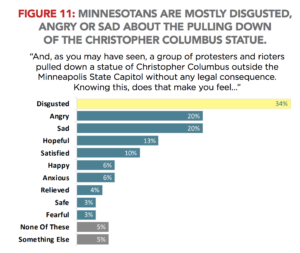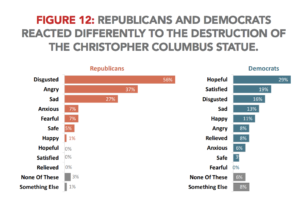Calm after the storm
In the midst of the overheated political responses to the Twin Cities riots, Minnesotans steadily support their cops but overwhelmingly expect reform.
After absorbing the shocking death of George Floyd in police custody, five days of riots, and then the response of the Minneapolis City Council to defund the police, Minnesotans in the new Thinking Minnesota Poll have stepped back and asserted a calm perspective over the whole situation.
For the current Thinking Minnesota Poll, Meeting Street Insights interviewed 500 registered Minnesota voters between June 15-17, via cell phones (40 percent) and landlines (60 percent). Minnesotans said they support law enforcement but thought the protests after George Floyd’s death were largely justified, and—in an exhibition of remarkable nonpartisanship—they expect policymakers to reform policing. Dismantling the police department, however, is not a viable alternative, they say. And, in a pointed message to the Minneapolis City Council, respondents say they will reduce their visits to Minneapolis restaurants and sports-and-entertainment venues if the police are defunded.
The survey tested Minnesotans’ attitudes toward local law enforcement. The results were overwhelming: 85 percent say they have confidence in the police in their community to act in the best interest of the public. Activists often say that the presence of police makes them feel unsafe, but if so, they are a very small minority. In keeping with the confidence Minnesotans express in local law enforcement, 85 percent say the presence of police makes them feel safe, with only 12 percent saying police make them anxious. (Figure 1)
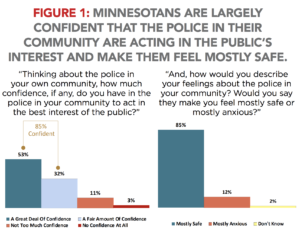
The poll found little difference between Twin Cities metro residents and those who live in Greater Minnesota. Three-quarters of residents in Hennepin and Ramsey Counties expressed confidence in their police departments. On this and other questions, the Twin Cities suburban counties look very much like Greater Minnesota in their support for law enforcement. (Figure 2)
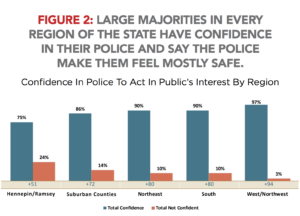
“Defund the police,” a rallying cry on the Left, finds little support in Minnesota. By 68 percent to 27 percent, Minnesotans oppose the defunding or disbanding of the Minneapolis Police Department. And when asked about defunding or disbanding their own police department, the results were even more overwhelmingly negative: Minnesotans are opposed by 76 percent to 20 percent, with 67 percent strongly opposed. (Figure 3)

Here again, Minnesotans do not divide by geography. There is no county in the state where anywhere near a majority wants to defund or disband the police, and the suburban counties around the Twin Cities are nearly as firmly opposed as residents of Greater Minnesota. In fact, there is no majority in any demographic, regardless of age, gender, party, or region, that is in support of defunding their local police department. (Figure 4)
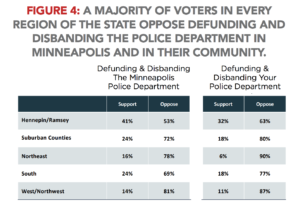
The Thinking Minnesota Poll should serve as a warning to Minneapolis politicians who say they want to do away with the Minneapolis Police Department. It asked respondents whether such a move would make them more likely or less likely to come to Minneapolis to visit restaurants and bars, or to attend sporting events, concerts or other gatherings. The results were stark: fully 72 percent say doing away with the Minneapolis Police Department would make them less likely to visit the city. Only 12 percent say that such a move would make them more likely to come to Minneapolis. Again, that sentiment is virtually uniform across the state. (Figure 5)
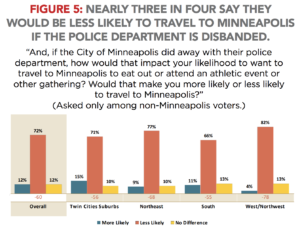
Some politicians on the left say that they want to disband the Minneapolis Police Department, and in some cases other departments as well, on the ground that racism is “systemic” and therefore reform is impossible. This defeatism flies in the face of the civic-minded optimism that generally has characterized Minnesota’s history. Not surprisingly, it is overwhelmingly rejected by the respondents in our survey.
In fact, Minnesotans are highly optimistic about the direction in which policing will move in the future. A remarkable 85 percent say it is likely that “real police reform and policy changes” will occur as the result of the death of George Floyd while in police custody. It is noteworthy that there is no significant difference based on party affiliation: 87 percent of Democrats and 84 percent of Republicans are optimistic about the chances for reform. (Figure 6)
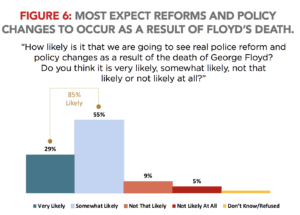
The news media often blur the difference between protests and demonstrations on one hand, and riots, looting and arson on the other. But Minnesotans are subject to no such confusion. They understand the difference between demonstrating and looting, and their attitudes toward these activities are entirely different.
Minnesotans strongly support the right to protest and demonstrate; in fact, 77 percent say these activities were justified as the result of George Floyd’s death. But attitudes toward riots are precisely the opposite. Fully 78 percent say that the “burning and looting of buildings and businesses in Minneapolis” were unjustified, while only 4 percent say the burning and looting were fully justified, with 17 percent considering such activities partially justified. (Figure 7) Once again, this issue does not deeply split Minnesotans. A majority in every demographic regardless of age, gender, party, or region believes the riots were not justified.
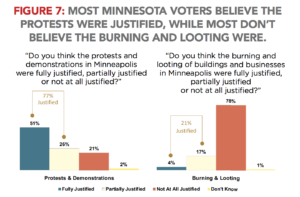
While rioters destroyed substantial areas of Minneapolis and St. Paul, most Minnesotans, including most in Hennepin and Ramsey Counties, did not feel personally endangered. Overall, 73 percent of Minnesotans say they did not feel threatened. But perhaps the more telling finding is that more than 30 percent of respondents in Hennepin, Ramsey, and the surrounding Twin Cities suburban counties did worry about their own personal safety. (Figure 8)

Elsewhere in this issue of Thinking Minnesota, John Phelan and Tom Steward detail the response of the responsible authorities—including Mayor Jacob Frey and Governor Tim Walz—to the riots, looting and arson in Minneapolis and St. Paul. One issue with that reaction was that the National Guard was not called out until several nights of rioting had already taken place, and even then, in insufficient numbers. By a two-to-one margin, Minnesotans agree with that critique. Sixty-five percent say that “the National Guard should have been deployed sooner and in greater numbers,” while only 32 percent disagree. (Figure 9)
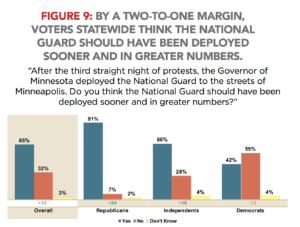
With the damage caused by looters and arsonists estimated at $500 million or more, the question whether state funds should be used to pay for the damage inevitably arises. This proposal is unpopular with most voters. Overall, 39 percent don’t want any state dollars used to repair damages caused by rioters, while only 5 percent want the state to pick up the whole tab. The farther one gets from the urban cores of Minneapolis and St. Paul, the less support for using state funds. (Figure 10)
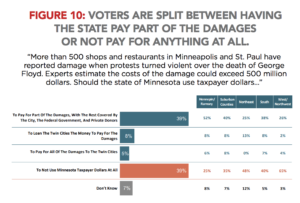
Vandals tore down the statue of Christopher Columbus on the grounds of Minnesota’s Capitol, apparently with the blessing of state authorities. This action was deeply unpopular with Minnesotans. Seventy-four percent say it inspired negative feelings in them: disgust (34 percent), anger (20 percent) and sadness (20 percent). Only a small minority report positive feelings about the lawless destruction of the Columbus statue. (Figure 11) This is perhaps another issue on which some of Minnesota’s politicians are out of step with the views of the state’s voters. However, it is also true that Republicans and Democrats reacted dramatically differently to the destruction of the Columbus statue. (Figure 12)
